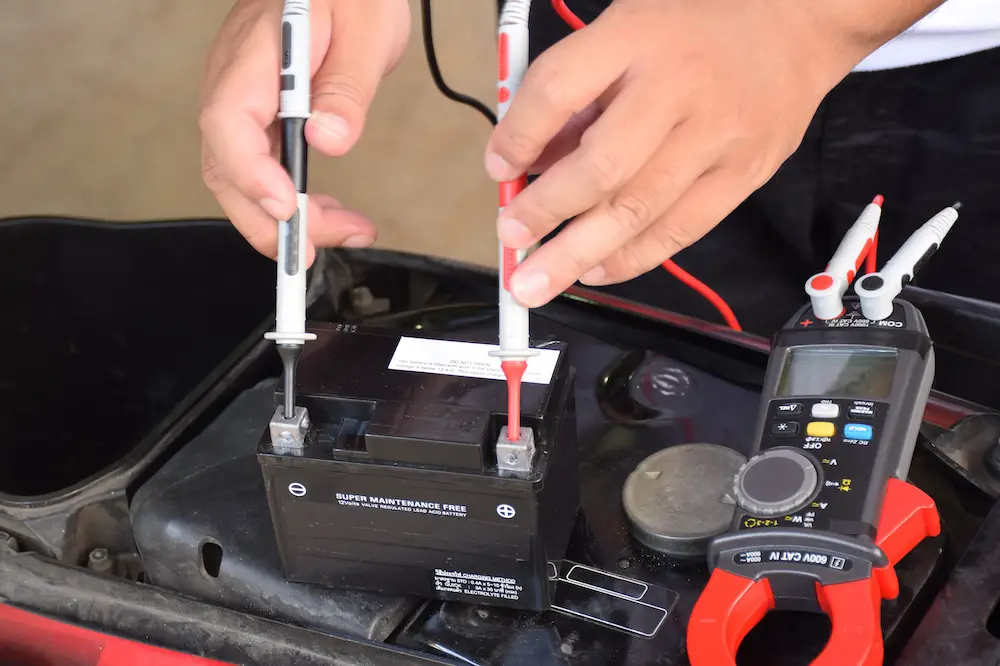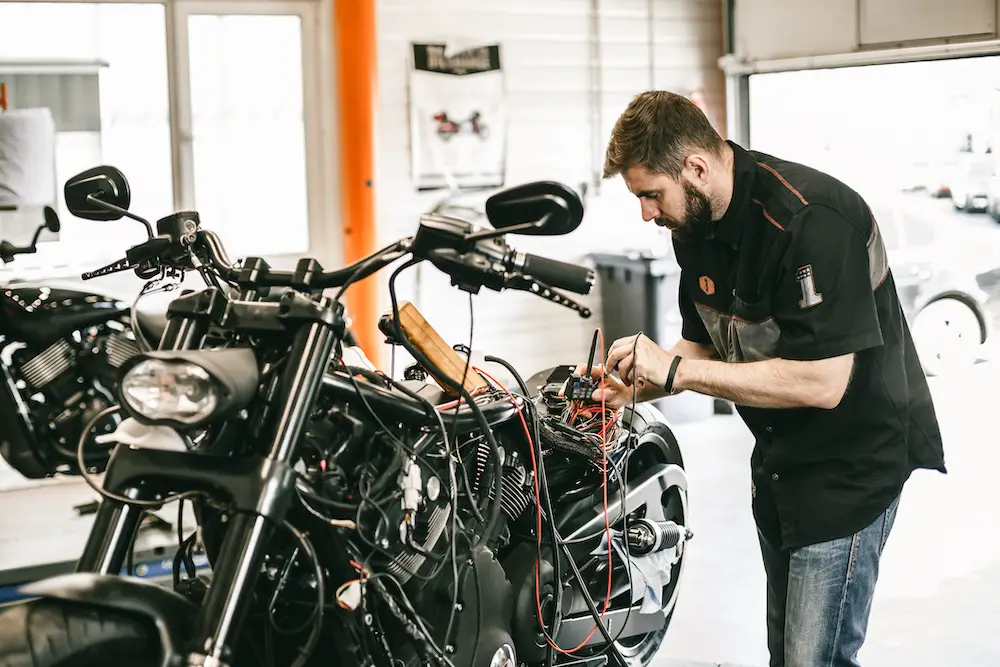All motorcycle owners encounter battery problems at one point or another. That is why you must know how to charge a dead motorcycle battery if you are a rider.
It is true whether you have an old battery that needs replacing or you just left the key on. Either way, you won’t be going anywhere for hours.
The good news is that you can bring your battery back to life and your motorcycle back on the road, albeit temporarily. There are several ways to do this, and we have outlined some of them for you. However, you must first learn how to check your battery and see if you need a charge or replacement.
How To Check Your Battery
To diagnose your motorcycle’s battery, you would need a multimeter. If you have one, you can check the standing voltage and see if your battery just needs a charge.
First, pull off your motorcycle’s seat or remove some of its bodywork to access the terminals. Get your multimeter and set it to 20 volts of direct current.
Connect the positive probe of your tester to the positive terminal of the battery and the negative probe to the negative terminal. Both your multimeter and your battery are probably color-coded, so this step is fairly easy to do.
If your multimeter reads 12.73 volts or higher, the problem might not be your battery at all. You might have a blown fuse, a bad spark plug, a dirty carburetor, or several other potential problems.
If the voltage is lower, give your battery a charge using one of the methods we’ll discuss later. If it is too low, around 12.06 volts, your battery is beyond saving.
If this is the case, there is a good chance that you would need to buy a new one.
How To Charge a Dead Motorcycle Battery
Once you have determined that your battery is why your motorcycle won’t start, you need to find ways to charge it. Here are some of your best options:
Use a Battery Charger
If you have a float, trickle, or smart charger (or you can borrow one), you can use it to charge your battery. Still, you need to check what type of battery your motorcycle has.
These devices will only work on lead acid, gel, and absorbed glass mat or AGM types. Lithium batteries, including lithium-ion, lithium-iron, and lithium-phosphate, need specialized chargers, and they would vary from one manufacturer to another.
A trickle or manual charger is easy to use since it will just convert AC power to DC. Simply connect the positive clamp to the positive terminal and the other to the motorcycle’s unpainted, grounded metal surface.
That said, you would need to monitor it while charging as it will keep pumping energy unless you turn it off.
A float charger cycles on and off and provides a steady but gentle stream of current to the battery. It works similarly to a trickle charger, except it will automatically turn off once the charge is full.
Finally, a smart charger keeps track of the battery charge progress. It typically charges at different rates to prevent damaging the battery.
Most models have a desulfation mode that removes the sulfur from the lead plates using varying voltages. As a result, you could not use them on lithium batteries.
Lithium batteries often have onboard management systems that could not survive the pulsing of electricity. If you have this type of battery, you would need a dedicated charger.

Jumpstart Your Battery
If you do not have access to a charger, don’t worry. There is another way to revive your battery until you get it fully charged or replaced. For instance, you can try jumpstarting it.
However, you would need to rely on the kindness of other motorists for this to work. You would also need a pair of jumper cables.
If you don’t have one on you, try to find another motorist who has one. Your best bet is car drivers, as they often have jumper cables in their trunks.
Also, car batteries are bigger and have far more capacity, which means they can get the job done easily. If you choose this route, leave the car off while jumpstarting your motorcycle.
While it is necessary for a car to be running if jumpstarting another car, it is not the case for your motorbike. You have a smaller battery that does not need the same amount of energy to charge.
Connect the jumper cable’s red clamp to the dead battery’s positive terminal to start the process. Make sure the clamp is not in contact with any metal, as this could cause a spark.
Next, connect the black clamp to the frame of your motorcycle. Choose a spot with no paint to avoid scratching the exterior.
Connect the other red clamp to the positive terminal on the car’s working battery. Again, make sure that it does not touch any metal surface to avoid creating sparks that could lead to an explosion.
After this, attach the black clamp to the car battery’s negative terminal. Remember to double-check the connections every step of the way to avoid damaging the batteries.
Once everything is set up, try starting your motorcycle. If your battery has some energy left, your bike should work after a few tries. Leave it on and give it a few minutes to warm up.
Finally, remove the cables following a specific order. Disconnect the black clamp on your motorcycle’s battery first, then the black clamp on the car battery.
Next, remove the red clamp from your bike’s frame, then the other end from the car battery. Be careful not to let the clamps come into contact with each other until they are all disconnected.
Push-Start Your Motorcycle
Sometimes, you won’t have access to the right tools or equipment to charge or jumpstart your motorcycle. Fortunately, you can try one more thing before raising the white flag.
If you are on a flat surface, call a few people over to give you a push. If you are on a sloped surface, you can try this on your own.
First, turn the ignition on and put the bike in the second or third gear. Next, have your friends push you or roll downhill, then start popping the clutch.
Release the clutch once you feel that you are at jogging speed. If this doesn’t work, try again, but release the clutch at a faster speed this time.
Once the engine kicks over, shift to neutral and press the brakes. Try to rev the engine as much as possible so it does not die. From there, you can drive to the nearest repair shop or head home if you have the needed tools there.
Moving Forward
Once you have made your way home or to a repair shop, make sure you find out what went wrong. It certainly helps if you know how to charge a dead motorcycle battery, but you need to do more. The key is to fix the issue, as the dead battery is probably just the symptom.

